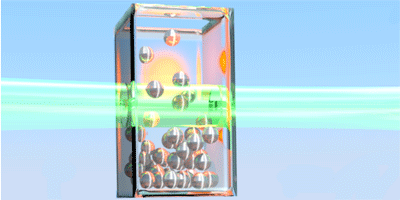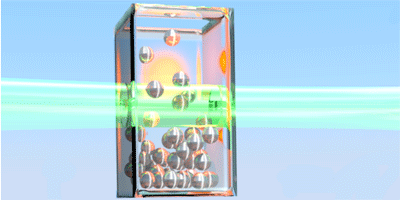Shaking Up a Grain-Based Laser
Laser light can be generated from randomly ordered materials, but so far the randomness has been fixed. Now, researchers have produced laser light by shaking a box of grains. Viola Folli of the Sapienza University of Rome, Italy, and her collaborators were able to alter the laser spectrum by varying the shaking intensity. The experiments, described in Physical Review Letters, may open a new realm of mechanically controlled photonic devices.
Random lasers don’t match our cartoon picture of a laser having a long cavity for collimating the beam. Instead, these unorthodox lasers are made of powders, colloids, and other disordered assortments that scatter light multiple times in different directions, while an accompanying gain medium provides the amplification. The scattering elements have typically been too small for mechanical manipulation, but granular materials could offer some “control” over the random configurations. In particular, grains can switch from a solidlike to gaslike state when shaken sufficiently hard.
Folli and her colleagues wanted to explore whether grain dynamics could lead to novel optical effects. They started with millimeter-sized metallic spheres and immersed about of them in a fluorescent dye (the gain medium). A vibrating plate shook the grains from beneath, while an external laser provided optical stimulation. The emitted light showed a peak at nanometers, which was due to random lasing but controlled by the vibrational motion. In addition, when the shaking reached a certain magnitude, a second peak appeared around nanometers. The authors claim this additional lasing arises from a few grains forming a short-lived cavity within the dynamic system. – Michael Schirber





